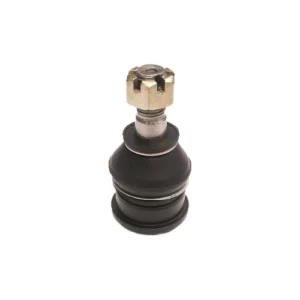Ball joints in a vehicle’s suspension system are typically located at specific points within the suspension setup. They connect several key components, allowing for controlled movement and articulation of the suspension.
The typical locations and components connected by ball joints include:
Front Suspension:
- Upper Ball Joint: The upper ball joint is often found at the upper end of the vehicle’s front suspension. It connects the upper control arm to the steering knuckle or spindle, allowing for vertical suspension movement and steering input transfer.
- Lower Ball Joint: The lower ball joint is typically located at the lower end of the front suspension. It connects the lower control arm to the steering knuckle or spindle. The lower ball joint is crucial for supporting the vehicle’s weight and controlling wheel movement.
Rear Suspension (If Equipped):
- Lower Ball Joint: In some rear suspension setups, there may be a lower ball joint, similar to the front suspension. It connects the lower control arm to the wheel hub, enabling vertical movement and load distribution.
- Other Suspension Components: Some vehicles have different types of rear suspension configurations, such as solid axles, trailing arms, or independent rear suspensions. In such cases, ball joints may not be present, or their locations and functions may differ.
Ball joints are integral components that allow the suspension to articulate and adapt to road irregularities. They provide flexibility and controlled movement while ensuring that the wheels maintain proper alignment with the road surface. Properly functioning ball joints are essential for the vehicle’s handling, China ball joint suppliers safety, and ride comfort. It’s important to note that the presence and location of ball joints can vary based on the vehicle’s make and model and the type of suspension system used.
Are there specific maintenance and inspection guidelines for extending the lifespan of ball joints in a vehicle?
Yes, there are specific maintenance and inspection guidelines that can help extend the lifespan of ball joints in a vehicle. Regular maintenance and inspections are crucial to ensure that ball joints remain in good condition. Here are some guidelines for maintaining and inspecting ball joints:
Maintenance Guidelines:
- Follow Manufacturer Recommendations: Adhere to the manufacturer’s recommended maintenance schedule for your specific vehicle. This may include the recommended interval for inspecting and servicing ball joints.
- Lubrication (if applicable): Some vehicles have greasable ball joints. If your vehicle is equipped with these, follow the manufacturer’s recommendations for greasing intervals. Proper lubrication helps reduce friction and wear.
- Check and Maintain Proper Wheel Alignment: Proper wheel alignment is essential to prevent uneven wear on the tires and excessive strain on the ball joints. If your vehicle’s alignment is off, have it adjusted promptly.
- Suspension System Inspection: Regularly inspect the entire suspension system, including ball joints, for signs of damage, wear, or corrosion. The suspension system should be checked during routine maintenance services.
- Avoid Overloading: Avoid overloading your vehicle, as excessive weight can put extra stress on the suspension and ball joints.
Inspection Guidelines:
- Visual Inspection: Periodically inspect the ball joints visually. Look for signs of wear, damage, or corrosion. Inspect both the upper and lower ball joints if your vehicle has a front suspension setup.
- Check for Play: With the vehicle safely lifted off the ground and the wheels suspended, try to move the wheel and the suspension components. Any noticeable play or looseness in the ball joints is a sign of wear and should be addressed.
- Listen for Unusual Noises: While driving, pay attention to any unusual noises, such as clunking or knocking sounds when going over bumps or while turning. These noises can indicate issues with the ball joints.
- Inspect Rubber Boots: Many ball joints are equipped with rubber boots to protect them from debris and moisture. Ensure that these boots are intact and not torn. Damaged boots can lead to contamination and wear of the ball joint.
- Check for Leaking Grease (if applicable): If the ball joints are greasable, check for any signs of leaking grease. This can indicate a problem with the joint or the need for regreasing.
- Professional Inspection: For a comprehensive assessment and repair, consult a qualified mechanic or service center experienced in suspension work. They can perform a thorough inspection and address any issues found.
- Wheel Alignment Check: If you notice any unusual tire wear patterns, consider having the wheel alignment checked. Misaligned wheels can lead to premature ball joint wear.
- Prompt Replacement: If you notice signs of wear, damage, or play in the ball joints during inspection, it’s crucial to replace them promptly. Delaying replacement can lead to more extensive damage and compromised safety.
Regular maintenance and inspections are essential for extending the lifespan of ball joints and ensuring the safe and efficient operation of a vehicle’s suspension system. Neglecting these components can lead to issues such as poor handling, uneven tire wear, and reduced ride comfort.
